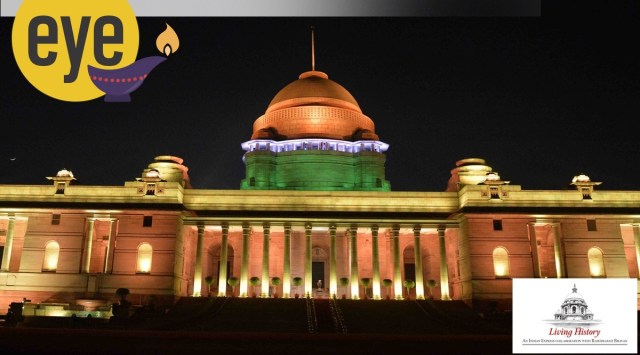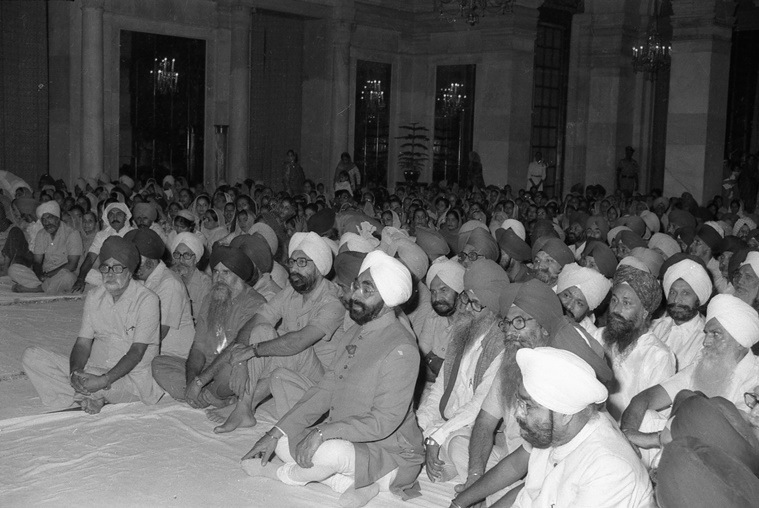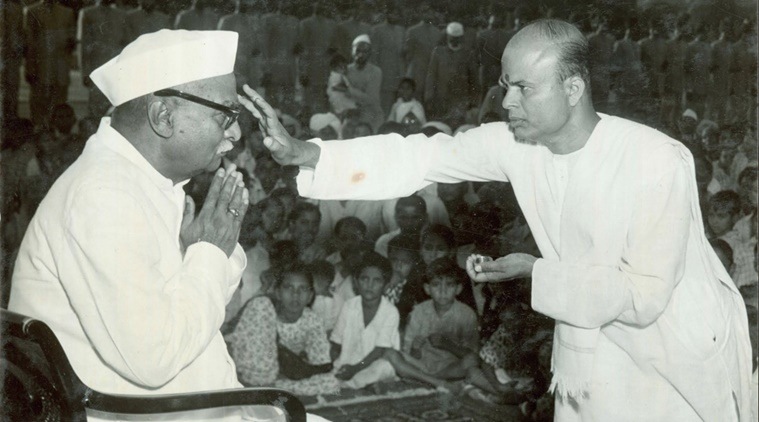Why APJ Abdul Kalam had discontinued iftar parties at the Rashtrapati Bhavan
Exclusive: For the President's Estate and the community living on the campus, every festival is also an occasion to celebrate India’s rich diversity
 Dynamic facade lighting of Rashtrapati Bhavan (Photo credit: Rashtrapati Bhavan Photo Archives)
Dynamic facade lighting of Rashtrapati Bhavan (Photo credit: Rashtrapati Bhavan Photo Archives)By Sunil Trivedi and Ankit Jain
Mangey Ram was entrusted with the task of maintaining the President’s library. And he was as passionate about organising the annual Ram Lila as he was about cataloguing books. The humble employee claimed to have directed many Ram Lilas that veritably proved to be nurseries for acting talents, even for Bollywood stars, including Shah Rukh Khan.
 Shah Rukh Khan with Mangey Ram (Photo credit: Rashtrapati Bhavan Photo Archives)
Shah Rukh Khan with Mangey Ram (Photo credit: Rashtrapati Bhavan Photo Archives)
Mangey Ram had been a regular visitor to the Ram Lila at the Rashtrapati Bhavan even after his retirement in 2014, until last year, when the pandemic interrupted our lives. Mirza Nafees Baig, who retired as a chief cook, also had the distinction of playing the role of the demon king Ravana, with the ease of a consummate actor. There are many such stories within the 330-acre campus of the Rashtrapati Bhavan.
It is the festival season again, and we will be celebrating Diwali soon. The community of more than 5,000 people within the President’s Estate represents a cross-section of India at its most diverse, as do their celebrations. Last year, however, the pandemic had snuffed out celebrations at the Rashtrapati Bhavan.
 President Giani Zail Singh attending at Ashoka Hall on October 13, 1983. (Photo credit: Rashtrapati Bhavan Photo Archives)
President Giani Zail Singh attending at Ashoka Hall on October 13, 1983. (Photo credit: Rashtrapati Bhavan Photo Archives)
When C Rajagopalachari became the first Indian occupant of the Bhavan, religious events and celebrations resonated with India’s cultural vibrancy. During the Diwali of 1947 — the first festival of lights in independent India — Rajaji happened to be the interim governor-general as Lord Mountbatten was away. He conveyed the greetings to the people on a sombre note that reflected the trauma of Partition: “We may not have the mind to indulge in festive rejoicings when we are surrounded by difficulties, and so deeply immersed in anxieties as we are today, but Deepawali is a great national day associated with hope and joy from time immemorial in India. The lights that are lighted on that day also represent the hope for more and more enlightenment…”
 President Dr Rajendra Prasad receiving Diwali greetings at Rashtrapati Bhavan, October 27, 1954. (Photo credit: Rashtrapati Bhavan Photo Archives)
President Dr Rajendra Prasad receiving Diwali greetings at Rashtrapati Bhavan, October 27, 1954. (Photo credit: Rashtrapati Bhavan Photo Archives)
The first President, Dr Rajendra Prasad, started the tradition of Diwali celebrations at the Rashtrapati Bhavan. His diary has an entry, dated October 18, 1952, noting that he witnessed the Diwali evening illumination for two hours. He also mentions that there had been very little arrangement for Diwali celebrations in 1951 and many people, especially the Prime Minister, had desired that Diwali celebrations at the Bhavan must be better organised. Nowadays, the Rashtrapati Bhavan shines bright every evening with the dynamic facade lighting installed ahead of the Republic Day. The illuminated Rashtrapati Bhavan, with the North and South Blocks and India Gate, has become a visual symbol of a modern India on the move towards a brighter future.
 President Dr S. Radhakrishnan receiving Diwali greetings from the staff and children at Rashtrapati Bhavan, November 4, 1964. (Photo credit: Rashtrapati Bhavan Photo Archives)
President Dr S. Radhakrishnan receiving Diwali greetings from the staff and children at Rashtrapati Bhavan, November 4, 1964. (Photo credit: Rashtrapati Bhavan Photo Archives)
The President’s Estate has a mandir, a masjid, and a gurdwara within it and a church adjoining it. Presidents have been visiting these places of worship. Former president Fakhruddin Ali Ahmed had sanctioned financial assistance for upgrading the mosque and the temple in the Estate. Presidents have been taking part in the Khatam Shareef ceremony, which is held upon the completion of the recitation of the Quran during the month of Ramzan. There was a tradition of holding iftar parties during Ramzan, though it was discontinued during the presidency of APJ Abdul Kalam (2002-07), who decided to use the amount spent on them for distributing food, clothes and blankets to orphanages.
President Ram Nath Kovind celebrates Eid and Janmashtami every year with residents of the Estate. In 2020, he gifted a high-end racing bicycle to a talented schoolboy named Riyaz, who was passionate about cycling but could not afford a racing bike. The president’s gift was like Eidi (gift) for Riyaz.
 On the occasion of Prakash Parv of Guru Nanak Dev Ji, President Kovind inaugurated the renovated PBG Regimental Gurudwara in the President’s Estate and paid his homage, November 30, 2020. (Photo credit: Rashtrapati Bhavan Photo Archives)
On the occasion of Prakash Parv of Guru Nanak Dev Ji, President Kovind inaugurated the renovated PBG Regimental Gurudwara in the President’s Estate and paid his homage, November 30, 2020. (Photo credit: Rashtrapati Bhavan Photo Archives)
Gurbani recital on Gurpurab, the birth anniversary of Guru Nanak, and meeting with Jain and Buddhist monks on Mahavir Jayanti and Buddha Jayanti have been regular events in which most presidents have participated. President Giani Zail Singh organised gurbani recitals at the Ashoka Hall. He also shared langar with the invitees in the true spirit of Guru Nanak’s message of Naam Japo, Kirat Karo, Vand Chhako (the three pillars of Sikhism — focus on god, honest living, sharing with others). Other presidents have also organised gurbani recitals and special programmes to celebrate Gurpurab. The gurdwara at the Rashtrapati Bhavan is managed by the President’s Bodyguard, the oldest regiment of the Army. President Kovind inaugurated the renovated gurdwara last year on the occasion of 550th birth anniversary celebrations of Guru Nanak.
The Bhavan also has living and growing links with the Buddha’s legacy. In November 2017, President Kovind planted a six-inch sapling from the Mahabodhi tree at Bodh Gaya, Bihar, in the Rashtrapati Bhavan’s garden, in the presence of representatives of interfaith delegations and members of the Harijan Sevak Sangh; today it is six-foot tall. In July, he planted one more sapling from the Mahabodhi tree in the Rashtrapati Bhavan on the occasion of Asadha Purnima, which Buddhists observe as the Dharma Chakra Day.
India has countless regional festivals, some of which are celebrated at the Rashtrapati Bhavan. In his memoirs My Presidential Years (1994, HarperCollins), president R Venkataraman recalls the celebration of Kolu — the festival of dolls — celebrated during Dussehra in Tamil Nadu. It was once organised in the Ashoka Hall under the guidance of the first lady, Janaki Venkataraman. “We had carried a Tamil Nadu tradition into the Ashoka Hall,” he wrote.
The warp and weft of the rich tapestry of Indian culture and spirituality have been woven and strengthened presidency after presidency at the President’s Estate by celebration of festivals. It is India at its festive and harmonious best.
Sunil Trivedi is Officer on Special Duty (Research), and Ankit Jain is Officer on Special Duty (Communications), at the Rashtrapati Bhavan
- 01
- 02
- 03
- 04
- 05






























